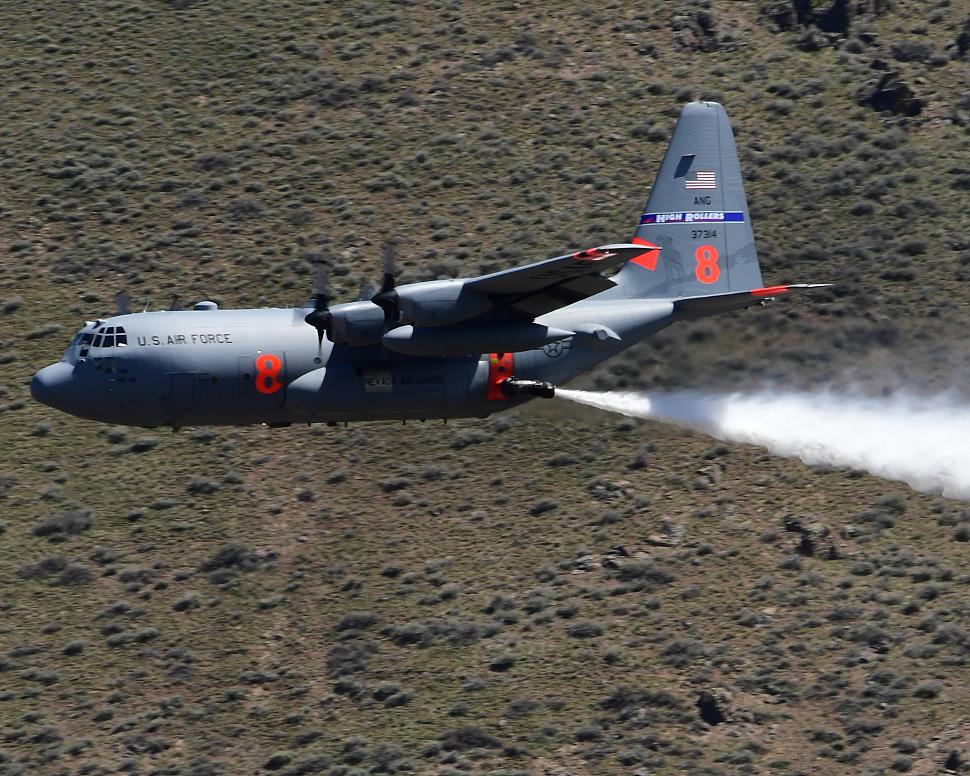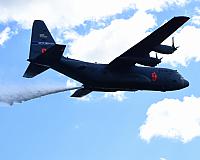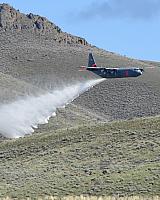C-130 News
C-130 Hercules News
Guard, Reserve units complete annual firefighting training with U.S. Forest Service
April 24, 2017 (by
TSgt. Emerson Marcus) -
121 sorties. 124 flight hours. 373,900 gallons of water dropped.

Impressive statistics for firefighting aircrew members and personnel from four different C-130 military units participating in a five-day Modular Airborne Fire Fighting System annual training sponsored by the U.S. Forest Service here. The training included Air National Guard units from California, Nevada and Wyoming and one from the U.S. Air Force Reserve in Colorado. In all, 400 people from multiple agencies worked the training and certification operation.
"The U.S. Forest Service has always been a strong partner with the Department of Defense when it comes to firefighting," said Col. Bryan Allen, commander of the Air Expeditionary Group, which oversees the four military units for the MAFFS mission. "This is probably one of the clearest examples of the benefits of using military aircraft in a civil support role and the U.S. Forest Service is the agency that does it the best. The U.S. Forest Service and the four airlift wings within the Air National Guard and the Air Force Reserve have really figured it out, with everything from logistics to funding, to execution, to standardization and the direct result is we save American lives and property using military crews and equipment in a civil support role. We’ve really built a strong partnership with the U.S. Forest Service over the last 44 years."
Water drops for training were executed on lands within the Boise National Forest and Boise District Bureau of Land Management.
The U.S. Forest Service's large MAFFS equipment — rolled into the back of a C-130 aircraft — can drop up to 3,000 gallons of water or fire retardant in six seconds through a nozzle on the rear left side of the plane.
The certification training includes classroom sessions and flight operations for military flight crews, lead plane pilots and other support personnel from the U.S. Forest Service and other wildland firefighting agencies in advance of the upcoming fire season this summer.
"We have recognized the benefits to combine training periodically for operational consistency and standardization, not only with the air wings but for our personnel, as well," said Kim Christensen, deputy assistant director for operations for the U.S. Forest Service. "The compelling reason to do a combined training again this year was the integration of the 152nd Airlift Wing, from Reno, into the MAFFS mission. We know we have a window of opportunity to get Reno proficient. The speed to that proficiency is important. When you have this kind of setting, with all four wings together, it provides a more complete setting to meet that objective."
The 152nd Airlift Wing was named the newest unit in the MAFFS mission last year, replacing the 145th Airlift Wing, North Carolina Air National Guard. The 145th is in the process of converting to C-17 aircraft.
Participating Air National Guard and Air Force Reserve units include the 153rd Airlift Wing from Cheyenne, Wyoming; the 302nd Airlift Wing from Colorado Springs, Colorado; the 146th Airlift Wing from Port Hueneme, California; and the 152nd Airlift Wing from Reno, Nevada. MAFFS is a joint Department of Defense and U.S. Forest Service program designed to provide additional aerial firefighting resources when commercial and private airtankers are no longer able to meet the needs of the forest service.
In the past decade, military C-130s equipped with MAFFS delivered about eight million gallons of fire retardant on wildfires around the U.S.
"Obviously, we have our overseas contingencies we respond to," said Lt. Col. Anthony Machabee, commander of the 152nd Airlift Wing Operations Group. "That is a huge part of what we do in the Air Force. We take a lot of pride in doing that. But this is a domestic operation that we also take a lot of pride in doing. For us, this is a tremendous opportunity to be a part of this mission saving property and life. I can’t speak more highly about this mission."

USAF C-130H #93-7314 from the 192nd AS loaded with the MAFFS drops a water line while training to contain wildfires just outside Boise, Idaho on April 21, 2017. [USAF photo by SSgt. Nieko Carzis]
"The U.S. Forest Service has always been a strong partner with the Department of Defense when it comes to firefighting," said Col. Bryan Allen, commander of the Air Expeditionary Group, which oversees the four military units for the MAFFS mission. "This is probably one of the clearest examples of the benefits of using military aircraft in a civil support role and the U.S. Forest Service is the agency that does it the best. The U.S. Forest Service and the four airlift wings within the Air National Guard and the Air Force Reserve have really figured it out, with everything from logistics to funding, to execution, to standardization and the direct result is we save American lives and property using military crews and equipment in a civil support role. We’ve really built a strong partnership with the U.S. Forest Service over the last 44 years."
Water drops for training were executed on lands within the Boise National Forest and Boise District Bureau of Land Management.
The U.S. Forest Service's large MAFFS equipment — rolled into the back of a C-130 aircraft — can drop up to 3,000 gallons of water or fire retardant in six seconds through a nozzle on the rear left side of the plane.
The certification training includes classroom sessions and flight operations for military flight crews, lead plane pilots and other support personnel from the U.S. Forest Service and other wildland firefighting agencies in advance of the upcoming fire season this summer.
"We have recognized the benefits to combine training periodically for operational consistency and standardization, not only with the air wings but for our personnel, as well," said Kim Christensen, deputy assistant director for operations for the U.S. Forest Service. "The compelling reason to do a combined training again this year was the integration of the 152nd Airlift Wing, from Reno, into the MAFFS mission. We know we have a window of opportunity to get Reno proficient. The speed to that proficiency is important. When you have this kind of setting, with all four wings together, it provides a more complete setting to meet that objective."
The 152nd Airlift Wing was named the newest unit in the MAFFS mission last year, replacing the 145th Airlift Wing, North Carolina Air National Guard. The 145th is in the process of converting to C-17 aircraft.
Participating Air National Guard and Air Force Reserve units include the 153rd Airlift Wing from Cheyenne, Wyoming; the 302nd Airlift Wing from Colorado Springs, Colorado; the 146th Airlift Wing from Port Hueneme, California; and the 152nd Airlift Wing from Reno, Nevada. MAFFS is a joint Department of Defense and U.S. Forest Service program designed to provide additional aerial firefighting resources when commercial and private airtankers are no longer able to meet the needs of the forest service.
In the past decade, military C-130s equipped with MAFFS delivered about eight million gallons of fire retardant on wildfires around the U.S.
"Obviously, we have our overseas contingencies we respond to," said Lt. Col. Anthony Machabee, commander of the 152nd Airlift Wing Operations Group. "That is a huge part of what we do in the Air Force. We take a lot of pride in doing that. But this is a domestic operation that we also take a lot of pride in doing. For us, this is a tremendous opportunity to be a part of this mission saving property and life. I can’t speak more highly about this mission."
Courtesy of Nevada Joint Force Headquarters Public Affairs
Related articles:
Forum discussion:
Tags
- Guard & Reservists provide surge support to Great Basin fires (2016-09-23)
- Nevada Air Guard unit begins MAFFS transition (2016-05-11)
- 'High Rollers' complete first MAFFS activation (2016-09-09)
- Reservists, C-130s depart to assist aerial firefighting efforts (2016-08-03)
- Reserve C-130s called up to fight wildland fires (2015-08-03)
- C-130 Fighting Falcon news archive
Forum discussion:
- Start a discussion about this article in the C-130.net forum.
Tags


